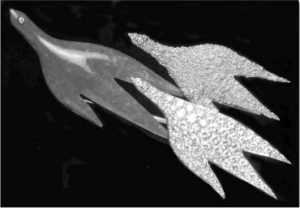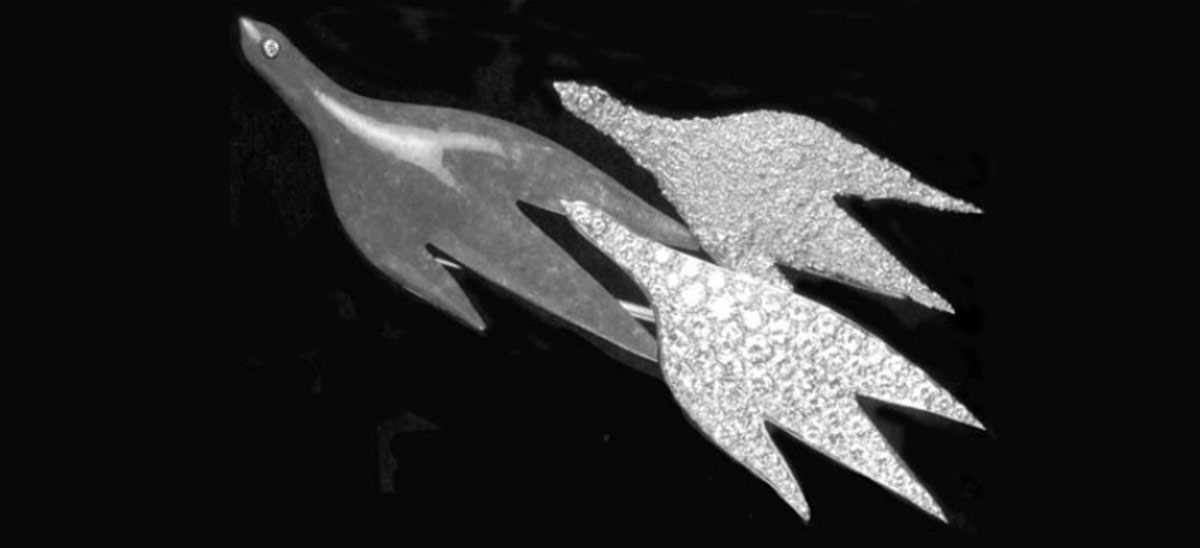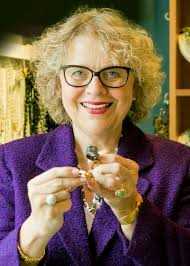
Between 1930 and 1960, the West experienced remarkable technological advancement and immense social awakening. As a decorative art, jewelery has never been a pioneer of cultural change, but many jewelers of that era echo the changing social customs by exploring their art as a means of expression and even questioning the symbol of wealth that jewels represent.
The world of the 1960s moves, evolves, disturbs. Revolt of young people, mini-skirts and psychedelic colors, contrasts that shock … In Quebec, it is the Quiet Revolution, the James Bay development project, and in Montreal, Terre des Hommes opens the province to the world. Arthur Penn’s Bonnie and Clyde films and Claude Lelouch’s man and woman make the crowds run.
The hippie movement is at its peak in the United States. In response to the Vietnam War, young people want to stand out from the mainstream and aspire to peace and love for all humans.
Art is more and more important. Vasarely’s optical art inspires fashion and jewelry designers, such as Courrèges and Pierre Cardin, among other things by geometric shapes that shatter, with gems that seem to be placed at random.
From the 1960s, the design of jewelry is moving more and more towards abstraction, Vogue magazine even says that they are “disfiguring”. Instead of simple decorative accessories following the fashion, they are considered as ornaments for the body, portable art objects born from the imagination of young artists.
The latter create prototypes that are subsequently produced in very limited editions. Big names, Max Ernst, Jean Arp, Georges Braque, Niki de Saint-Phalle and others, collaborate with skilled jewelers in the realization of these jewels carvings now very much sought after.
The creators are captivated by new materials, such as Plexiglas, which appeared during the Second World War for the construction of fighter jets. They also use uncut crystals and minerals (rock crystal, amethyst, agate, dioptase …) arranged with all kinds of new materials, such as vinyl, laminated acrylic plates, niobium, titanium and aluminum .
Enamel, stained glass, crystal, steel or silver decorate the creations. Hippie fashion advocates natural materials: wood, bone, ivory. The latter, very popular in the 1960s and 1970s, is later banned to protect elephants. The most common stones are tiger’s eye, coral, lapis lazuli, onyx, amazonite and carnelian. We recognize the style of the 1960s and 1970s by gold which is often very textured. This one can be crumpled, hammered, chiselled, granular or even oxidized. The spiky forms are in the spotlight. Platinum is not used much.
High jewelery still has its place with its noble materials and well-cut stones: diamonds, rubies, sapphires and emeralds. The big houses – Cartier, Boucheron, Bulgari and Tiffany – keep their affluent clientele, people who appreciate traditionally made jewelery. These high-end jewels are the symbol of a social status, a family heritage or an investment.
For example, the Greek jeweler Ilias Lalaounis quickly earned a good reputation thanks to the purchase by Aristotle Onassis of wedding gifts that he will offer to his fiancée Jacqueline Bouvier Kennedy.

Public interest and wealth are essential for the jewelery industry, which is what the 1960s offer. Two kinds of jewelery then appear. The jewels that are kept in the bank, decorated with important stones; for security reasons, copies with synthetic stones are worn. Also exist the everyday jewels which one benefits for the pleasure.
In the 1960s, the West experienced strong economic growth. Things slow down at the end of the decade as the price of oil from Middle Eastern countries rises. The Arabs become fervent buyers of jewelry because for them, the display of wealth and social rank is part of the culture.
We remember the 1970s for a kind of life more free and relaxed. Baby boomers are more educated. In Quebec, thanks to the strength of the dollar and charter flights, the discovery of the world is more accessible to them. The charms in Eiffel Tower, sombrero and palm, hung on the gold bracelet, are the tangible witnesses!
In fashion and music, it seems anarchy. The punk style with body-piercing and fluorescent hair rubs the nonchalant look with jeans, long hair and large jewelry metal and plexiglass. Twiggy, the English filiform mannequin, wears PVC or leather dresses, or made of plastic or metal discs. The trend is ethnic style: kaftans, exotic prints, shawls with fringes, boleros. Midis or long skirts, flared pants called elephant paws, crinkled blouses are typical of this period. We listen a lot to the Beatles, Barbara, Bob Dylan, Félix Leclerc, Robert Charlebois and Jacques Brel.
The 1970s also saw the death of Picasso at age 92 (1973), the invention of Bic’s disposable razor (1975), the Olympic Games in Montreal (1976) and the inauguration of the Georges Pompidou Center (1977). ) and the theatrical adaptation of Notre-Dame de Paris by Robert Hossein (1978).
As for jewelry, this era is characterized by the big and bold. In spite of an anti-capitalist campaign, the high society maintains its taste for imposing jewels, large colored stones and the diamond mainly set in the coveted yellow gold. The price of gold is also skyrocketing.
Many jewelers are influenced by traditional Indian jewelry in gold, set with cabochons of rubies, sapphires, emeralds and diamonds. The influence of African and Native American arts also brings silver jewelery decorated with turquoises, necklaces made of multicolored marbles. We also see the rock crystal, the tiger-eye, the pink quartz, the malachite, the carnelian, the ivory, the coral, the exotic woods, including the famous bois d’amourette. Another influence: images inspired by the conquest of space and by microtechnology. Metal and plastic are combined to create works that are more sculptures than jewels. We want to demonstrate that a metal or a material has aesthetic qualities even if it is neither rare nor expensive.
In the 1970s, women in the labor market can finally buy their own gold jewelry. Their budget is however limited, new lines of jewelry at medium price are created for them.

In Quebec, thanks to popular stores, including Distribution aux consommateurs, surprising quantities of 10-carat yellow gold jewelery for men, women and children have found takers: fashion signs of the zodiac, multiple chains neck or even at the ankle, rings on each finger, birthstones, medals “More than yesterday, less than tomorrow”, is a huge success. The jewelery trade accessible to all lives its hours of glory!
Some artists use their creations as political or social manifesto. The Englishman David Poston protests against the working conditions and exploitation of black miners in South Africa by exposing, in 1975, a wrought iron necklace in the form of handcuffs on which the words “Diamonds, gold and slavery are eternal “are encrusted in silver.
In Quebec, master jewelers such as Gabriel Lucas, Georges Delrue, Hermann Gutknecht and Georges Schwartz are acclaimed. Encouraged by media recognition, the next generation is emerging. Madeleine Dansereau, Louis Perrier, Roger Lucas, Michel-Alain Forgue, Louis-Jacques Suzor, Gloria Bass, Antoine Bassani and Gilbert Rheme now carry the torch.
In 1973, Armand Brochard founded the Montreal School of Fine Arts and Jewelry, which paved the way for many other creators.

